Father and Son
Here I am, holding a chick that is 12-15 days old. He looks a little sleepy.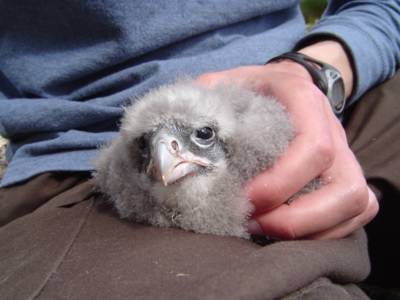
Here is Rich with an adult male that we just banded.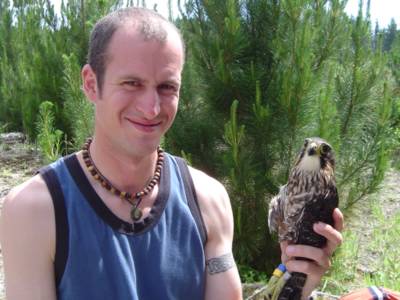
Posted by Hello
Blogging from Kaingaroa
Here I am, holding a chick that is 12-15 days old. He looks a little sleepy.
Here is Rich with an adult male that we just banded.
Posted by Hello
Here is Rich banding a falcon chick that is about 15 days old.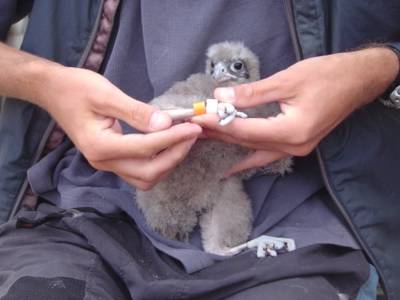
Posted by Hello
Today was a day off and I went out to Whirinaki Forest with Claude and Bob, who are monitoring Kakas. This is one of New Zealand's five native parrot species. They are a threatened species because introduced predators kill them as they nest, especially the females. They are a big bird, over 500 grams (over 1.2 pounds). Their outer feathers are a dull green, but underneath their wings is a deep crimson color. They have an impressively curved bill and produce a number of loud, gruff caw sounds. They nest inside rotted cavities in ancient rimu and kauri trees in the native bush. From egg-laying to fledging takes over three months, which is one reason they are vulnerable to predators. Claude uses five stacked mist nests that are hoisted on guide ropes into the forest canopy. They play recorded kaka calls to attract more birds.
The goal is to capture and radio-tag females in order to find nests and monitor fledgling success rates. These success rates are the measure of their predator control opperations. After three hours, just as the sun was getting too high to continue, we caught a female kaka! It turns out that this was the first female they had caught in two years! Once again, I am a fantastic good luck charm. I should add that they only net a few dozen times a year, but it was still remarkable luck for me. Or "jammy" as Rich would say. They attached a backpack with a radio to her, and we let her go successfully. While working on her, they gave her honey a couple times, which was rather entertaining. She didn't need any coaxing at all (I wish the bats were like that). She went right for it, with gusto, smacking her lips, er, beak and gurgling with joy. Imagine Homer: hmmmm, honey. She whined when they took it away. Anyway, that was a great oppurtunity combined with a great bit of luck!
One of the nests of chicks that we banded today was in Blood Gulley. This is a nest that has two parents that are leagues more aggressive than the other falcons. Most of the falcons swoop at you and then pull up if you wave your hands at them. They sometimes approach from the front, but not very close. The main risk to humans is if you don't seem them come from behind, they may smack the top of your head. With this pair, they like to attack from the front as well, and they never pull up. You can see them coming in with their talons out and ready to attack. I had to do a lot more ducking. Rich wanted us to collect prey remains from the nest, so I was down on my knees, picking up bird and rabbit parts while Shane tried to keep the pair at bay. Let's just say the birds won. I got tapped a couple times, but Shane got hit a lot. He got a number of long scratches and he has no hair, so they showed up quite well. When we got the chicks back, we sprinted out. It was pretty wild, but we survived and it makes the other nests seem much less daunting.
Today we spent the whole day checking old nest sites to see if the chicks were old enough to band. We ended up banding nine chicks in total. This kind of work is a lot less strenuous and more fun than just surveying all the time. Unfortunately, there are not too many days like this. I certainly feel more comfortable handling the chicks now, although not the adults. I got a lot of good chick pictures, and I want to post them as soon as possible, but I can't do it from the internet cafe.
When the chicks feel too warm, they actually pant like a dog, with their tongue hanging out. I didn't know birds did that.
Today we went out with a Department of Conservation manager and captured and banded a family of five falcons. The chicks were just as funny and cute as last time. Shane and Rich also caught the two adults. This was the first time we caught adults. They are actually about the same weight as the older chicks, but the adults are a tightly wound steel springs of muscle, instead of puffy balls of chubbiness. All of the measurements are the same, but the process is different. The chicks can just sit in your lap while you work, but the adults have to be tightly held and watched. I did not actually try to process them; I just watched Rich. As adults, their talons and beak are capable of doing some damage. We were able to release them all and it was a rather successful day.
Today we were checking on an old nest and the adults were nowhere around. We found the scrape (nest) and it had caved in. It had been built on top of a pile of sticks covered with hummus and in the rain, the loose dirt had given way and the eggs had fallen through. Rich said he had never seen that before. We found the three eggs, which are the size of chicken eggs and a medium brown-red with darker speckles. We opened the eggs and saw the three chicks in different stages of development. One was much smaller, suggesting it had fallen through first and died, while the other two were incubated a bit longer before falling and being abandoned. It was an interesting lesson in embryonic development.
Today was an exciting day! I found a new nest down in the southeast corner of Kaingaroa and Rich decided the chicks were old enough to band, so he sent Shane and me in to collect the chicks. This was the very first time we touched any of the falcons. The chicks are just barely starting to get flight feathers, but mostly they are just big puff-balls. They are a blue-grey color, instead of the brown with yellow flecks of the adults. They get up to 500 grams, which means a little over a pound. We stuffed them in a sack and then retreated a safe distance to process them. We measure the beak, wings, tail, tarsus (leg), and weight. We also put colored and numbered bands on and take a few microliters of blood (ie a few drops) for DNA testing.
The funny thing to me is how cooperative they are. If I put one in my lap, it will just sit there. If I put it in my hat, or on a fleece, it just sits there and watches. You can hold one and it won't struggle -- that is until you start prodding it for measurements. If they are afraid, they like to grab on with their talons. It is definitely is a pinch, and it can leave a small mark, but they can't break the skin. The other funny things about the little ones is that they have eye-lashes. It makes them look a lot less formidable. Overall, it was really great to get close to the falcons and to get to know them. Let's hope there are lots more!
After a long day in the field, Rich suggested we take a dip in Kerosene Creek. While it sounds horrid, it turned out to be fantastic and promises to become a regular habit. As I have mentioned before, this area is a major site of geothermal activity and Kerosene Creek is a hot creek. From a distance, it looks like a steam locomotive is passing through the forest, leaving a trail of white smoke above the tree tops. It is a small stream, from 3 to 10 feet wide and from 1 to 4 feet deep. The best thing about it is that it is a constant 99 F. Instead of paying for the spas in Rotorua, you can just slip into the creek and really relax. At points there is a god current going, which points your toes downstream and works like a gentle jet on your back. You can lean back and the current holds you up a bit, which makes for a very relaxing repose. It is amazing to me that this natural stream, heated by the ground, comes in at an ideal temperature. It seems that, statistically speaking, it would be far more likely that it would be too hot or not hot enough, but it is perfect. The only caution is that the hot springs here harbor amoebic meningitis. But I don't worry. It's not like anyone ever died of meningitis. What's that you say?
After Wai-O-Tapu, I hiked up Rainbow Mountain. It is named for the many colored layers of rock and soil that it is formed from. However, the eruption of Mount Tawera in 1886 covered a lot of the layers and colors in ash, so it is not as dramatic as it used to be. One of the nice things about the hour 2 hour walk was that the mountain is covered primarily in native bush instead of the boring old California pines where we work. Unfortunately, I did not have my guide book with me, so it was hard to ID a lot of things, but it was a good start getting introduced to some of the different plant forms here. I did see five-fingers, lots of fern, and some rimu. Otherwise, I need my book.
New Zealand sits along the border of two great tectonic plates, the Indian-Australian plate and the Pacific plate. The area where I am living and working is actually right along the most active part of that border, which makes it a major geothermal site. One of the best around here is Wai-O-Tapu, which is exactly where I went on my most recent day off. The site primarily features steaming, bubbling pools in many bright colors.
One highlight was the Lady Knox geyser which shoots a jet of water about 30 feet in the air once per day. The force is provided by underground water that is from 150 to 300 Celcius. The Champaigne Glass is a large deep pool that gives off copious amounts of steam and is rimmed with a bright orange border. The orange is due to arsenic in the water. One of the most fun spots was a mud pool 50 feet long that was bubbling in a most disgusting way. Active spots would simmer away and then suddenly vomit up a bellyfull of mud two or three feet into the air. Smaller spots would spit little gobs of mud up and roll about into thick gooey concentric circles. The whole area leaks enough sulfur gas that smoking is prohibited. They also want visitors to stick to the walkways because the crust can be thin in areas and if you fell through it would be instant death.
I got more pictures, but I still need to get posting sorted. Every computer I try has some other issue that won't cooperate, but I will get these up at some point.
Ahhhh! My first day off since I've been here. The job is a lot of walking, so it is nice to rest. It is my first day off and I am spending it all updating my website. I do it all for you, my web-fans. And the buckets of money. Since I have a lot to write I have broken it down and put up one post for each day so far. Scroll down to read what I have been up to. I have taken a number of good pictures, but this computer does not have a USB port, so I will have to post them later. Check back later to see them all!
We are wrapping up camping today, which is good because I am getting some blisters. A hot shower tonight and then a day off tomorrow! This is our place in Murupara: not exactly flash, but comfy enough.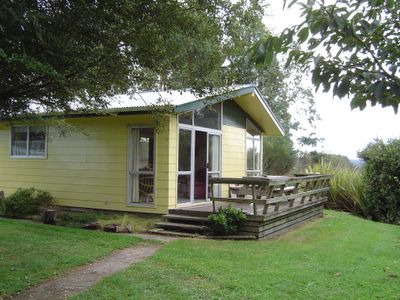
Posted by Hello
OK, it's a slightly out of focus, but how cute is that?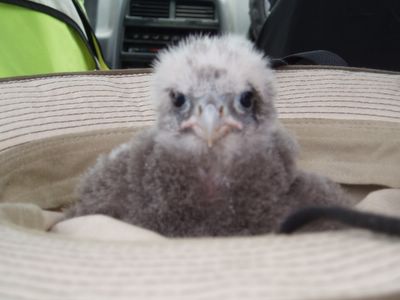
Posted by Hello
We found 2 new nests today for the first time since day 1! And Shane (the other tech) and I found one without Rich for the first time, which is a good milestone. We were in this huge compartment and had been there for several hours when I heard a feeding-pass along one edge. Shane and I trudged over there and started combing the area. We were only 30 feet away when the female popped up and we were quickly able to spot 4 eggs. Go us! Especially me. Go me!
The forest is huge and predators like falcons tend to be at low densities, so we do a lot of fruitless searching. It was nice to have some results again. Woohoo!
We are headed off for some camping. Kaingaroa Forest is rather large and the cabin is towards the north end, so we also have a campsite in the south end. We will spend 3 days there to cover some of the southern region. Should be lots of bucolic fun!
Apparently, some disgruntled Catholics decided to blow up the Protestant King andParliment in England in 1605, but were stopped at the last minute. To this day, England, New Zealand, and who knows what other backwater regions, still commemorate this event. What puzzles me is that even though the assasins are supposed to be the bad guys in this story, they named the holiday after one (Guy Fawkes) and they celebrate with explosives (fireworks). It would be like calling July 4th "King George III Day" and eating bread pudding. Crazy Limeys!
The young ones are really cute. They are pure white and completely helpless. If you click your tongue at them, they will look at you. Again, I will have to post the pictures later. Most falcons have three young each, but some have four. At this point I have only seen chicks twice.
Despite lots of hours in the field, we have not found any new nests since the first day. We have returned to some old nests Rich had found previously to check on their progress and that is when we saw the chicks. We should get to see them grow up, which is great! This one is about a week old.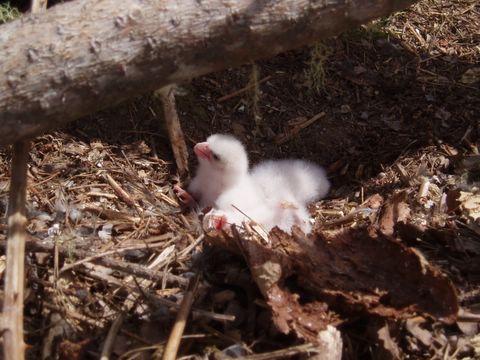
Posted by Hello
Over here, the American election is on Wednesday, November 3rd, due to the date line. I would say that it a million times more attention than the New Zealand election got in the US, but only a fraction of the attention it got over there. It was the top story on the news, but after a few minutes they went on to more local issues. Apparently Kiwis liked Kerry by about 2:1 which means that the political climate is somewhat similar to Europe, but with the anti-Bush feeling much more muted. After the outcome was clear few took it hard, with most talking heads arguing better the devil you know than the one you don't. The story line here is that cultural conservatives focused on gay and abortion issues determined the election, and not Iraq. (Moral Issues Decide US Election) Frankly this seems a strange interpretation as for 18 months, politics has been all about Iraq. But I am in a bit of an information bubble here.
It doesn't really seem like a forest. Unfortunately for me, we are working in a commercial forest growing California pines and not in native bush. What is really strange is that the falcons have taken to nesting in clear cuts. This means I'm not really in a normal forest at all, but walking around an open area fill with tree trash. The way these birds have taken to this man-made habitat is a very interesting phenomenon that is not well understood. Historically, falcons nested in epiphytes (plants that grow on trees, not in the ground) found in podocarps (trees). Even in the trees, they did not build nests, but used the epiphytes to nestle the eggs. Now, falcons still nest in the old fashion, but they have also taken to the clearcuts, which is where we are working. I'll post pictures later.
For now, the primary task at work is to find nests. To start with, we divide the forest into compartments (sections) and work through them. In each compartment, we simply tramp about and when we get close to a nest (mostly through luck and persistence) the falcons give an alarm call. Then we zero in on the call and walk there. As we get close, the birds start attacking and you can tell how close you are by how forcefully they attack. It is like that "warmer/colder" game you play as a kid, but with more ducking. You have to keep one eye on the sky and one on the ground and walk carefully. When we find a nest, we note what is in it (usually eggs or chicks, sometimes a computer logged onto Falcon Blog), and then we hightail it out of there. I have pics, but I will have to post later.
What is interesting is these birds actually nest on the ground and they don't build a nest, but simply scrape the ground a little so the eggs don't roll away. That's it.